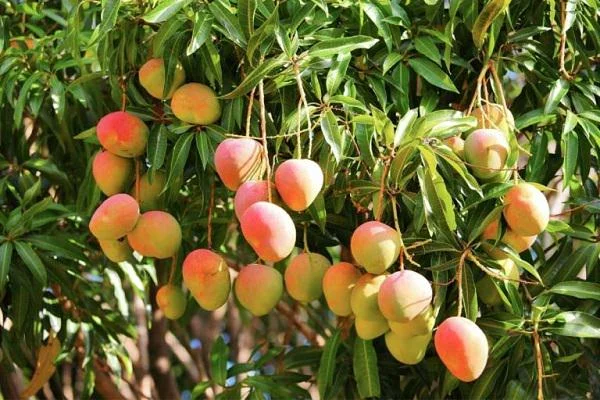With its long, oblong green leaves and white flowers, the mango tree (Anacardiaceae) is a striking addition to any garden.
They are native to Asia, these trees thrive in tropical and subtropical climates, like in California, Florida, Hawaii, and Puerto Rico, where frost is nonexistent. If you’re planting a mango tree, spring is the best time to do so. And the best part? You only need one tree to produce fruit, as each flower has male and female parts.
Most common mango tree varieties:
- Rainbow
- Honey
- Keitt
- Kent
Care
The two most important things to pay attention to when caring for a mango tree are providing enough light and proper soil conditions. Other than that, if the climate is right, you should have no problems with keeping a mango tree happy.
- Soil: While mango trees can withstand different soil types, they prefer a sandy loam that is both lightweight and drains well. The optimal soil pH for these trees ranges from slightly acidic to slightly alkaline, which is around 5.5 to 7.5.
- Water: For optimal care, it’s recommended to water your mango tree when the top layer of soil has dried out, but avoid letting the tree remain in waterlogged soil.
- Light: These trees need at least 8 hours of direct sunlight daily for healthy flower and fruit production. If you are growing it in a pot, although indoor south-facing windows may suffice, it is preferable to move the pot outside to achieve maximum sunlight exposure.
- Temperature: To keep your tree healthy, it’s important to avoid exposing it to temperatures below freezing, and ideally, maintain temperatures above 70 F°(21 C°). Even temperatures in the 40s can cause flowers and fruit to drop, so it’s essential to ensure a warm environment.
Propagation indoors
Did you know that you can also grow a mango tree from a cutting? Since this is a tree, the process is a bit different, but it’s a great way to create new trees and it’s pretty inexpensive too! Just remember that cuttings don’t always result in a strong root system, but it’s still worth giving it a try.
- Find a healthy branch of a mango tree and cut a 6- to 8-inch portion in the summer.
- Remove the leaves, flowers, or fruit from the lower half of the cutting and dip the cut end in rooting hormone.
- Plant the cutting in a small container with moistened soilless potting mix, and keep it in a warm, humid spot with bright, indirect light. Keep the soil moist but not soggy.
- Wait patiently for several weeks for the roots to grow before transplanting the new mango tree.
Pruning
Pruning mango trees is different from pruning deciduous fruit trees. Mango trees usually don’t require annual pruning to promote flowering or increase yield. They are terminal bearers, with flowers appearing on mature wood. Remember, pruning at the wrong time can damage your tree.
It is mainly done to shape the tree, improve air circulation, and allow sunlight penetration. This enhances fruit color and quality, as well as facilitates pest and disease control. Developing a good tree structure with three to four main trunks is important.
For young trees, initial shaping involves allowing them to grow over 3.28 feet (1 meter) before cutting back to 2 – 2.3 feet (0.6-0.7 meters), promoting strong branches. Branches should be pruned to promote a spreading tree and remove inward or crossing growth.
Bearing trees may not need annual pruning, but if necessary, two main pruning times are suggested: after harvest and pre-flowering. The aim is to remove low-hanging branches, open up the tree’s center, maintain hygiene, and potentially reduce tree size.
Old trees can be rejuvenated through moderate to severe pruning. Proper pruning tools like secateurs, lopping shears, and a pruning saw are recommended.
Common Pests
- Mango scab
- Mango scale
- Mango leafhoppers
- Mango seed weevil
Frequently Asked Questions
Mango trees grow best in tropical climates, with the mango tree growing zones being the southernmost portions of Florida and California, Hawaii, and Puerto Rico.
How long does it take to grow a mango tree?
It can take several years for a mango tree to grow and start producing fruit, typically around 3-5 years. However, the exact time can vary depending on various factors such as growing conditions and the age of the tree at the time of planting.
Do mango trees need a lot of water?
It really depends on the age of the tree. They require regular watering during the initial years, but they do not need lots of it once established. Newly-planted mango trees should be watered daily for a few weeks to keep the soil moist, and for the first few years, they should be watered once a week or as needed. Older mango trees only need to be watered during times of severe drought.
Are mango trees high maintenance?
Taking care of a mango tree involves some tasks like watering, pruning, and fertilizing, but they are not too demanding. Once the tree is established, it can be relatively easy to maintain, particularly if it is growing in its ideal environment.
What is the lifespan of mango tree?
The lifespan of a mango tree is typically around 100 years, although some trees (like the one in East Khandesh) have been known to live for up to 300 years in ideal growing conditions.

